Написанный vs сгенерированный текст: «естественность» как категория текстовая и психолингвистическая
Aннотация
В контексте развития технологий текстовой генерации оппозиция «естественность – неестественность текста» трансформируется в новую дихотомию: «естественность – искусственность». Цель данной статьи – исследовать феномен естественности в данном контексте с двух точек зрения: анализа лингвистических характеристик естественного текста на фоне сгенерированного (искусственного) и интроспективных представлений информантов-носителей русского языка относительно того, каким должен быть «естественный» текст, и чем он должен отличаться от сгенерированного. Материалом для исследования послужил параллельный корпус кинорецензий на русском языке, состоящий из двух подкорпусов: рецензий, написанных людьми, и сгенерированных большой языковой моделью на основе промптов, представляющих собой начала отзывов из первого подкорпуса. Для сопоставительного анализа двух подкорпусов применялись следующие методы: метод компьютерной обработки текстов для подсчета значений 130 метрик лингвистической сложности текста; метод психолингвистического эксперимента; метод экспертного анализа текста; метод сравнительно-сопоставительного анализа. В результате было определено, что с точки зрения собственных лингвистических характеристик «естественные» тексты отличаются от сгенерированных преимущественно большей гибкостью синтаксической структуры, допускающей как пропуск или сокращение структур, так и избыточность, а также − большей лексической вариативностью. Естественность же как категория психолингвистическая связана с автостереотипными представлениями информантов о том, какими когнитивными характеристиками обладают люди как вид. Анализ ошибочно атрибутированных информантами текстов (сгенерированных, размеченных как естественные, и наоборот) показал, что ряд характеристик данного автостереотипа переоцениваются информантами, другие же, в целом, коррелируют с лингвистической спецификой текстов из подкорпуса написанных рецензий. В заключение сформулированы определения естественности как текстовой и психолингвистической категории
Ключевые слова: Контролируемая генерация, Естественность, Текстовая категория, Психолингвистическая категория, Метрики лингвистической сложности, Эксперимент, Русский язык
К сожалению, текст статьи доступен только на Английском
1. Introduction
Over the past decades, the theory of text elaborated a very solid repertoire of categories in terms of which any text could be described. Using the material of different languages, the researchers detail the concepts of text coherence (Wilson, 1998) and text cohesion (Dashela and Mustika, 2021; Rachmawati, Sukyadi and Samsudin, 2021), its temporality (Schramm, 1998) and informativeness.
Rapid development of AI technologies has stimulated the emergence of a new reality – artificially generated texts. The principal textual categories became not only objects for description, but also tools for generation quality assessment. Different research teams promote their own metrics to evaluate the quality of generated texts: for instance, BERTscore (Zhang et al., 2020) computes the similarity of two sentences as a sum of cosine similarities between their tokens’ embeddings; Self-BLEU metric shows how diverse the output of the generated model is: ‘a higher Self-BLEU score implies less diversity of the document, and more serious mode collapse of the GAN model’ (Zhu et al., 2018: 4); METEOR metric (Lavie, Agarwal, 2007) and ROUGE (Lin, 2004) rely on the word overlap mechanism and compare the generated sentence to one or more human-generated reference sentences; recently elaborated metric to evaluate the structuredness of the GAPELMAPER text (Mikhaylovskiy, 2023).
However, with the growth of the performance of neural models and their widespread usage, another requirement appears: to make generated texts as natural as possible so their readers don’t feel “people do not usually say it this way” or “there is something strange in this sentence”. The final goal of generative models is to be able to generate texts that, when read, are perceived as being written by a human without any doubt that they were written by a human.
In such perspective, we see two amazing questions arise:
1. What is naturalness as a text category? Can we give a definition to it? If yes, it may help us, first, to “fine tune” models in a proper way to make them generate better – it means “like humans do”, in a maximally anthropomorphic way;
2. What is language naturalness as an intersubjective concept that we, humans, have in our subconscious to identify ourselves as species? How do we imagine humans usually speak and what properties distinguish them, as we think, from machines, even well trained, when they speak? This second heuristics seems to have something of magic because it refers to a very subtle substance of human attitudes, expectations and anticipations, but at the same time, this formula of naturalness, if found, will boost generation power and quality.
The present paper searches for finding answers to the research questions articulated above.
Our article is organized as follows: in Section 1, we explore the theoretical grounding for the category of naturalness; Section 2 is devoted to the overview of our methodology and data – we detail our experiments with film review controlled generation which gave us two parallel corpora of texts: actual reviews written by people and synthetical reviews generated by the Large Language Model (LLM) in response to prompts taken from actual reviews; in Section 3, we analyze both corpora comparing a) their self-BLEU score; b) their metrics of text complexity; c) results of our Human evaluation experiment focusing on the informants’ subjective opinions about the naturalness of reviews – human-written and generated by AI; Section 4 summarizes our definitions of the naturalness as a linguistic and psycholinguistic category; in the Conclusion section, we finalize all our intuitions and evidence obtained in experimental work.
2. The concept of naturalness in the Humanities
Naturalness is a complex phenomenon which provokes discussions of scholars in different spheres. If we want to follow the academic tradition, we should start from the philosophical point of view.
Philosophers consider two main approaches to investigate naturalness: to see it in a moral light (in situations where naturalness is morally relevant or in some other sense provides an important criterion for decision making) or as a gradient category (in cases where something could be evaluated as more natural than something else) (Siipi, 2008). No doubt, it is the last approach that is of interest for us. Within it, researchers distinguish three types of natural forms: historically-based, property-based and relation-based. If the first type could be omitted, the last two seem very productive for our further discussion. Property-based forms appear when entities are found natural or unnatural because of their current properties or features. As we shall see, when linguists and translation professionals consider the concept of naturalness, it is precisely these forms that they mean. Relation-based forms emerge when people tend to consider those entities to which they are accustomed and which occur relatively frequently to be natural. We will adopt this point of view when analyzing naturalness as an attitude of informants when they assess the naturalness of generated texts while evaluating the quality of generation.
Naturalness as a property-based category first attracted the attention of experts in translation studies. This is not surprising in the sense that the main task of the translator is to make sure that the recipient of the text does not have a feeling that the text is foreign, that it is alien to the mode of textual production that is appropriate in his or her native community.
However, the question is not easy to answer – researchers’ views differ. M. Rogers bases his argumentation on the feeling of a lack of “naturalness”, which he defines as "something in the source text that is not yet adequately transparent in the target text: a particular word, a cohesive device (or lack thereof), a collocation, a distribution of information" (Rogers, 1998: 10). P. Newmark links naturalness with the concept of settings of the text – situations, contexts where the text is typically published or found (Newmark, 1987); L. Venuti − to the concept of “fluency” and “invisibility”, which suggests that naturalness is characterized by being modern, widely used, standard, and consistent in its variety (Venuti, 1995). More pragmatically, naturalness is seen as the result of communicative or free translation strategies used by the translator (Serce, 2014) or as a phenomenon being permanently in tension with the translation accuracy category (Obeidat et al., 2020).
In linguistics, perhaps, the first to speak of naturalness as a characteristic of language was Ch. Bally. Calling linguists to study not the sterile correct language of classical texts, but real speech, he defined this very real speech as an expression of our natural desire to live, of our vital energy. He wrote: “Since life is not driven by pure ideas, the language that expresses them cannot be a logical creation. In contrast to organized language, which is intellectual and logical, an affective language emerges, which is like the vital principle of language. It’s constantly at work, because in contact with life, even the most apparently objective ideas are impregnated with affectivity and become value judgments” (Bally, 1913: 25).
In other words, for Bally, naturalness means the illogicality, the emotionality that the encounter with real life brings to the strict canvas of language.
Many years later, J. Sinclar, seeking to refine naturalness in the way it could be measured, proposed three scales: neutrality − isolation – idiomaticity. A natural sentence occupies a middle range of each of these: not very neutral, but not overly affective; not completely isolated, but not very text-dependent; not sufficiently obvious to sustain any variation, but not exposed to unmotivated variation (Sinclair, 1983).
Accepting the idea that naturalness is a relative category, Orešnik (2002: 143-145) offers his own list of language naturalness basic characteristics that are available for scaling: the principle of least effort (processing ease), prototypicality, cognitive simplicity, and relative frequency of “natural” items and constructions.
In computer science, when willing to evaluate the naturalness of texts generated by the model, researchers invite assessors to participate in the so called Human Test. The participants are asked to answer a question: “Is this sentence (or utterance, or text) natural?” (Novikova et al., 2016) based on their intuition. Not rare are the experiments based on the Likert scale rating: the informants are provided with a sentence under evaluation and a five-points scale where 1 means unnatural and 5 – sounds very naturally. They are asked to rate the naturalness of the sentence. In such tasks, while doing assessment, people react introspectively based on feelings and attitudes formed in their everyday experience.
To summarise, firstly, the category of naturalness as defined by linguists remains in fact somewhat invisible - it is something that language users do not recognise as something marked. Considered by professionals in computer science in a very pragmatic way, naturalness looks like an attitude to species-specific features of humans felt by themselves.
In our paper, trying to find an answer to the question of what naturalness is, we obtained two corpora of texts − a corpus of written film reviews and a corpus of film reviews generated on the basis of prompts from the first corpus. We then sequentially applied 3 types of analyses to this material: 1) automatic metrics used to assess generation quality in computer science, 2) linguistic metrics commonly used to assess text complexity, and 3) a psycholinguistic experiment involving assessors who manually assessed text naturalness.
3. Aim of the study
The aim of this study is therefore to provide a possible answer to the question of what is naturalness as a category of text?
A priori, we assume that naturalness denotes something that is intrinsic to humans, something that derives from human nature. In other words, our goal is to characterize human-written review texts as natural per se against the background of generated texts by comparing them on three levels of analysis: text diversity measured by cosine distance between adjacent sentence embeddings, text linguistic complexity measured automatically by 130 metrics, and text subjective evaluation made in a psycholinguistic experiment. The features found in written texts and missing in generated texts are interpreted as naturalness features, which we use to categorise naturalness.
Our hypothesis could be formulated as follows: if naturalness is actually a relevant human- written text property, it must be “palpable” either on the level of formal metric used to evaluate text generation quality; or – on the level of linguistic metrics of text complexity; or – on the level of language users’ intuition.
4. Data and methodology
4.1. Data
In order to generate the data, we have finetuned the ruGPT3[1] language model on a dataset of cinema reviews for controlled text generation with a choice of sentiment. We have focused our attention on reviews for three reasons: 1) such texts are short and their small size ensures fast and high-quality training of the LMM without using very large computing power; 2) they belong to the genre of opinion texts, tending to express subjectivity, affectivity and personality – in this way, they are very revealing when we deal with the dilemma “natural vs artificial” and their inconsistency in style, flippancy in language etc. are very “useful” when searching for “human likeness” ; 3) film reviews express sentiment, emotions and, by using them as data to train model, we complicated the generation task – we wanted to test naturalness in emotionally saturated texts.
The original dataset of 200,000 reviews with three types of sentiment (positive, neutral, and negative) was collected from a Russian-language web platform by using the Selenium library in Python. The negativeness or positiveness of the review is marked by special emoji when a review is published on the platform. As negative opinion always prevails, to balance the sentiment distribution, we set a limit of 20,000 reviews for each sentiment (Margolina, 2022; Kolmogorova, Margolina, 2023).
To set up ruGPT language model we didn’t apply routine steps of text preprocessing (converting text to lowercase, removing special characters and stop words, or lemmatization) because such data cleaning can significantly reduce the accuracy of the transformer model (Alzahrani and Jololian, 2021). The only stage of preprocessing was tokenization.
We have trained three models: ruGPT3Large, P-tuned (Liu et al., 2022) model and a model trained on the basis of the methodology of the Transformers Reinforcement Learning (Mnih et al., 2015). As the first of the three models mentioned had performed best, we used data from it in our further experiments.
A simple method for addressing the style transfer task involves performing a basic fine-tune of a LMM. “This approach represents a novel contribution to the field of style transfer, offering a new, yet simple means of leveraging LMMs for stylistic manipulation of text data: fine-tuning of LMM on the dataset with included prompt in it” (Margolina, 2022: 16).
In order to input the data into the model, a transformation was applied to convert the original csv table format into a plain textual file format (.txt) with a prompt:
[<s>Sentiment: [positive, neutral, negative]\nText:[text of the review]</s>]
Incorporating reviews with a prompt into the model serves to facilitate the memorization of patterns by the ruGPT3 (Li et al, 2022). This is achieved by utilizing the second segment of the prompt, which serves as a continuation that the model must generate, namely, the review itself.
The training parameters influence the output and the quality of the fine-tuned LLM (Table 1). The parameters were chosen to fit ruGPTLarge on the home GPU memory (NVIDIA GeForce RTX 4090, 24 GB memory). We chose the minimal batch size – 1 and the learning rate is the default one. With these settings and GPU, the large model took 6 and a half hours to be finetuned.
Table 1. ruGPT3Large fine-tuning parameters and ruGPT3Large generation parameters
Таблица 1. Параметры «тонкой настройки» модели ruGPT3Large и параметры генерации модели ruGPT3Large (Margolina, 2022)
The repetition penalty parameter was adjusted to five in order to decrease frequent repetitions. No_repeat_ngram_size restricts the appearance of repeated bigrams in the text, further promoting diversity (Table 1).
Top_k parameter removes the least probable tokens below the k-token, improving the quality of text by removing off-topic words. As in some cases, there is a huge pool of relatively possible words, top k sampling makes the text less realistic and diverse. To address this issue, we applied top_p sampling (Holtzman et al., 2019), which consists in selecting ‘the highest probability tokens whose cumulative probability mass exceeds the pre-chosen threshold p’ (ibid., 5). This technique permits to avoid sampling extremely unrealistic tokens, but it preserves diversity when the highest-scoring tokens have low confidence.
Finally, early stopping can be used to prevent the model from generating endless or very long sequences. This is achieved by setting the parameter to stop the beam search when a certain number of sentences are finished per batch.
Table 2. presents a sample of the ruGPT3’s sentiment-controlled text generation results in Russian for three distinct sentiments.
Table 2. Example of results obtained in sentiment-controlled text generation
Таблица 2. Пример полученных результатов контролируемой генерации по параметру сентимента
In our further experiments we use four samples: 1) a sample of 1190 human-written reviews from a well-known Russian film review platform; 2) a sample of 1190 reviews generated by the ruGPT3Large model using the prompts from the first sample and controlled by the parameter of their sentiment (like those that are shown in the Table 3); 3) a sample mixed from two mentioned above corpora and consisting of 36 reviews (18 generated and 18 written) exposed to the Human Evaluation Test; 4) a sample of 126 comments given by informants when answering about introspective intuition they were guided by while labeling texts as written or generated.
4.2. Methodology
Two of our subcorpora of 1190 texts are compared twice: firstly, by using metrics to evaluate generation quality; secondly, by exposing them to a number of metrics of linguistic text complexity. A mixed subcorpus consisting partially of generated reviews and partially of written ones was exposed to texts naturalness assessment in the Human evaluation test (130 informants participated).
As a result, we obtained a restrained subcorpus of texts wrongly attributed by assessors (synthetical texts – to written ones and vice versa) and a collection of informants’ comments demasking their introspective intuition they were guided by while labeling. We grouped generated text features and written text features introspectively indicated in informants’ comments into 1) syntactical, 2) stylistic, 3) lexical features, and 4) features manifesting themselves on the level of textual categories, and 5) on the level of text affectivity. Then, we did a linguistic analysis of the pool of mislabeled texts according to the set of linguistic features built by informants previously. To make the logic of our work more explicit, we visualize our workflow (Figure 1).
Figure 1. Research workflow
Рисунок 1. План исследования
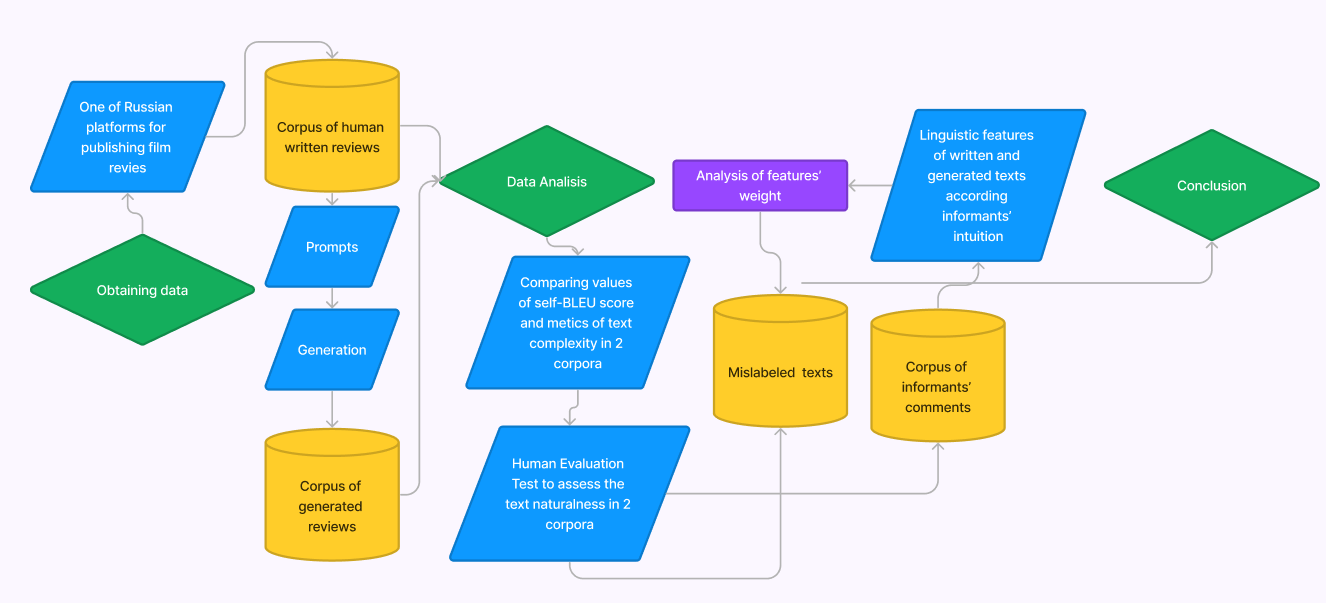
4.2.1. Metrics to evaluate generation quality
To evaluate formally the quality of obtained generation, we used two well-known metrics: BERTscore and self-BLEU.
BERTscore, introduced in (Zhang et al, 2020), is an evaluation metric widely applicable in text summarization, machine translation, and text simplification. For example, in our case it calculates contextualized text embeddings and gauge the semantic similarity from 0 to 1 between model-generated reviews and the original reviews prompted by the same input. The model presumes that 1 signifies complete textual similarity (every word is repeated in both sequences) and 0 indicates no identical words between the two sequences.
Another metric, the self-BLEU score (Zhou & Bha, 2021), measures the diversity of generated text by comparing sentences within the text. It is calculated by treating each generated sentence of one sample as a "reference" and comparing it to the other using the BLEU (Bilingual Evaluation Understudy) score, which measures similarity between two texts. Lower self-BLEU scores indicate greater diversity in the generated text.
By considering self-BLEU scores, we can evaluate whether the model can produce diverse sentences while upholding quality and coherence. This evaluation aids in identifying potential overfitting issues, as a high self-BLEU score may suggest that the model is generating repetitive or clichéd outputs, potentially limiting its applicability in real communication (Celikyilmaz, 2021).
4.2.2. Text complexity assessment
To feature human-written texts and their synthetical counterparts on purely linguistic level, we use a computer model elaborated by O. Blinova and N. Tarasov (Blinova, Tarasov, 2022). It covers all existing text complexity metrics. However, we rewrote the code to run the model with our data.
The texts of two subcorpora (written and generated) were subjected to such computational analysis in parallel.
4.2.3. Human evaluation test and expert analysis
To access the subjective perception of the degree of texts naturalness, we applied another method – the method of psycholinguistic experiment.
Our pool of respondents consisted of 130 (mean age=21.3) students of the Department of Philology of HSE University in Saint-Petersburg. For us, it was crucial to invite people sensible to text quality, to text style. The respondents were recruited via an open call published in student publics in the social network VKontakte. Via Google form service each of the informants was invited to read 36 texts (one by one) and 1) to hypothesize what kind of text they read (Who is the author of the review? – AI or Human); 2) to assess the naturalness of the text on a five-point scale (a score of 1 denotes entirely artificial text, while a score of 5 signifies text that appears as if exclusively crafted by a human writer); 3) to formulate markers they had used to distinguish “natural” text from generated one. The interface is presented in Figure 2. The informants had no limit of time while working with 36 texts and our tasks. Each informant was working from his/her home computer.
We intentionally did not use the structured survey method. Firstly, we could not offer the informants a list of criteria by which they could evaluate the naturalness of the text as these have not yet been developed in the NLP scientific community. Secondly, there is an established tradition of the Human Evaluation Test to choose between explanatory or confirmatory questions (Schuff et al., 2023).
We focused on the first one, because “in the case of an exploratory research question, an experiment should be designed to collect initial evidence which can then be used to generate post hoc hypotheses” (Ibid: 5).
Figure 2. Interface of Human Evaluation Test on Google Forms
Рисунок 2. Интерфейс для проведения психолингвистического эксперимента
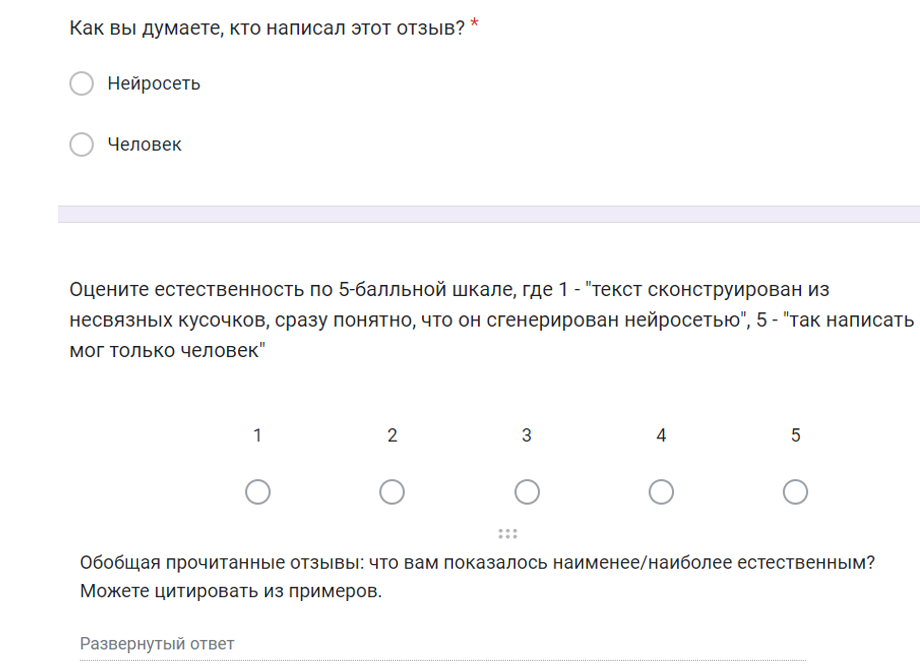
After having collected all statistics of human evaluation, we selected generated texts wrongly categorized as human-written and vice versa.
To determine whether the informants were really relying on the introspectively formulated features of a human-generated or written (in our terminology, "natural") review text, while assessing texts in experiment, we invited experts-linguists (N=3). They were given the task of identifying the characteristics of the informants in texts that had been incorrectly rated by the informants.
5. Results
5.1. Generation quality evaluation
As we can see (Table 3), the Fine-tuned ruGPT3Large model shows a rather high value of BERTscore of 0.674, which indicates that the model generates a new text closely resembling the reference text.
To test the self-BLEU score we also put in comparison our dataset of human-written reviews.
Table 3. BERTscore and self-BLEU counting results
Таблица 3. Результаты подсчета метрик BERTscore и self-BLEU
The findings presented in Table 3 demonstrate that the Fine-tuned ruGPT3Large model attains the lowest average self-BLEU score, indicating its ability to produce highly diverse texts. Interestingly, both the human-written and generated texts display substantial diversity, with the metric values slightly favoring the neural-generated texts over the human-written ones.
Thus, formal generation quality metrics did not say anything about the naturalness of generated text. Moreover, the self-BLEU score shows that the LLM slightly outperforms the human ability to write diverse texts. In this regard, we decided to resort to linguistic analysis and psycholinguistic experiment. The results of both procedures will be described in the following parts of the article.
5.2. Text complexity assessment
To compute the values of a set of 130 metrics of text complexity in two subcorpora, we partially rewrote and ran the code for the model previously elaborated in (Blinova, Tarasov, 2022). On Figures 3-7 below we demonstrate the obtained results. As the majority of metrics are similar, we comment only those which show differences.
The Comma proportion metric (comma_pr) testifies that generated texts have less commas than written texts and the Number of numeric characters (N) metric – that generated texts contain more numbers than written reviews (Figure 3).
Figure 3. Comparison of values of text complexity metrics in written reviews (actual) and generated reviews. Part 1
Рисунок 3. Сравнение значений метрик сложности текста в двух выборках: написанных и сгенерированных отзывах. Часть 1
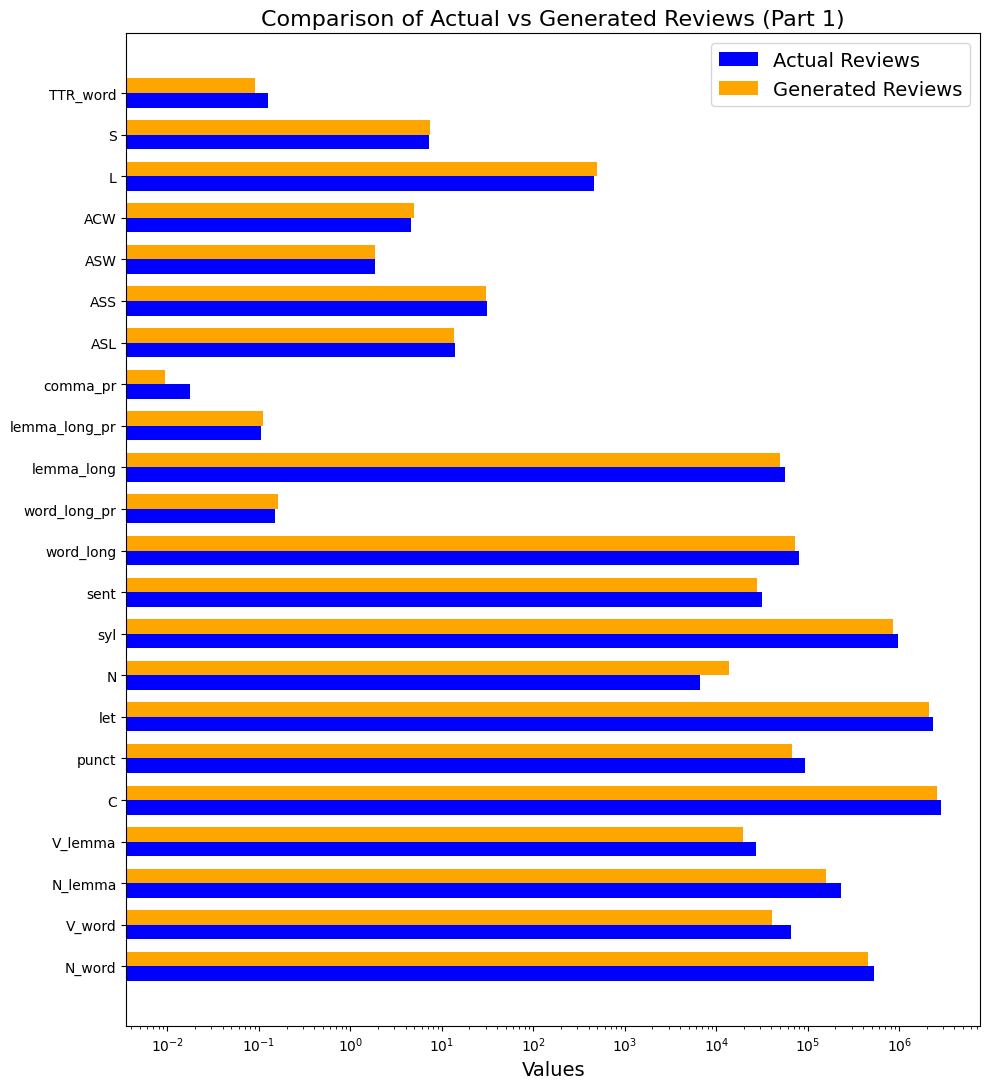
For two readability indices (Сoleman-Liau index (CLI) and ARI) out of five (Figure 4), the metric values are higher for generated texts (i.e., they are more difficult to understand) than for written texts. When comparing the values of the other three metrics, no differences were found (Flesch reading easy (FRE_GL), SMOG and Dale–Chall Index (DCI)).
Generated reviews also have lower values for Proportion of hapax legomena (for lemmas) and Proportion of hapax dislegomena (for lemmas) (hapax1_pr and hapax2_pr) than written reviews. This means that when generating a text, models are more likely than humans to repeat words they have already used in that text (rather than new occurrences). This is also indicated by the lower values of the Yules K metric for words (YulesK_word), which is commonly used to assess the lexical richness of a text.
Figure 4. Comparison of values of text complexity metrics in written reviews (actual) and generated reviews. Part 2
Рисунок 4. Сравнение значений метрик сложности текста в двух выборках: написанных и сгенерированных отзывах. Часть 2
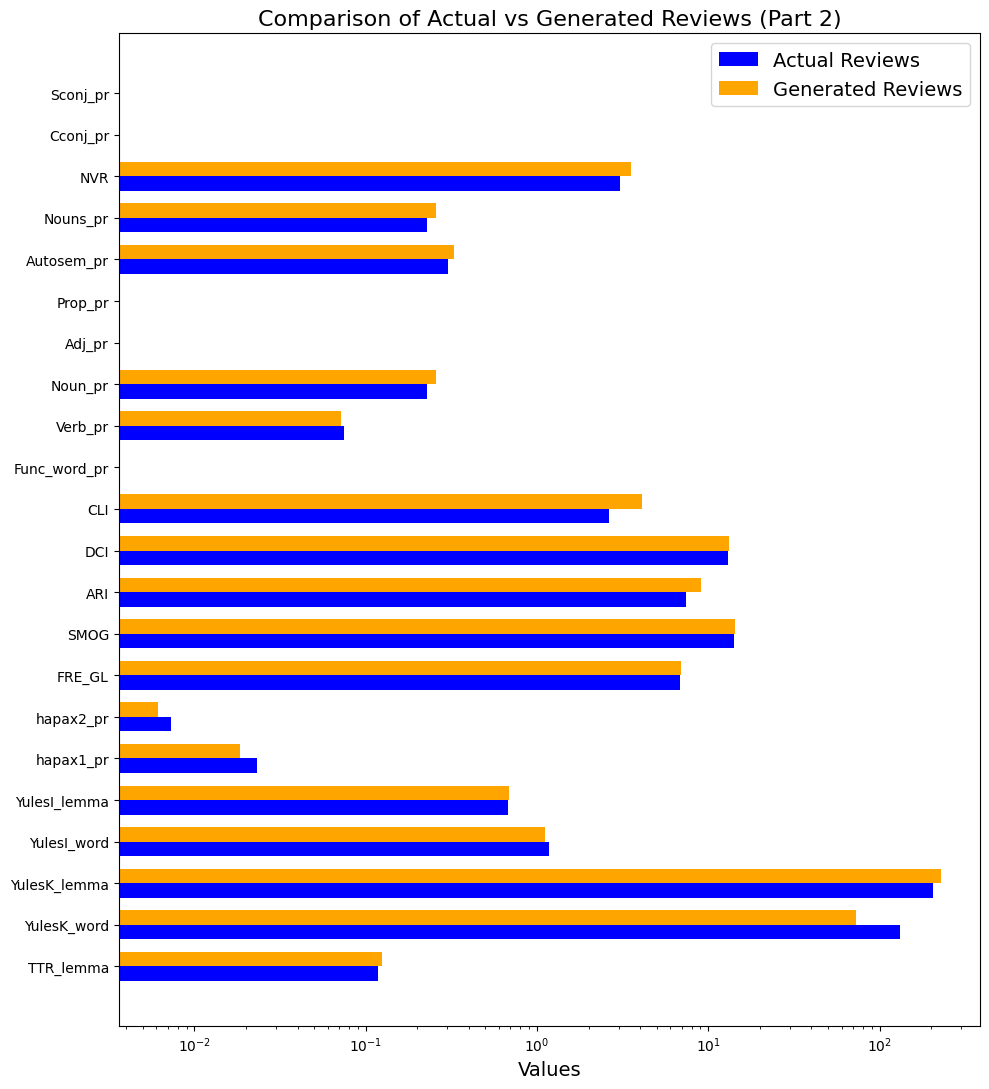
Metrics measuring the proportions of stable part-of-speech patterns show that, compared to written reviews, the generated texts contain significantly more bi- and trigrams, including nouns (Figure 5): NOUN + VERB (Pos_ngrams_2_pr), ADJF + NOUN (Pos_ngrams_4_pr), NOUN + NOUN (Pos_ngrams_5_pr), NOUN + NOUN + NOUN (Pos_ngrams_6_pr).
However, generated texts are inferior to written texts in terms of the number of the part of speech bigram “adverb+gerund” (Figure 5 − Pos_ngrams_9_pr). Likewise, generated reviews contain fewer adverbial participles (Grnd_pr), short adjectives (Adjs_pr), comparative forms (Comp_pr) and predicatives (Pred_pr) than written texts. The latter are inferior to the generated texts in terms of the number of numeric characters (Proportion of numerals (Numr_pr)) (Figure 5).
Figure 5. Comparison of values of text complexity metrics in written reviews (actual) and generated reviews. Part 3
Рисунок 5. Сравнение значений метрик сложности текста в двух выборках: написанных и сгенерированных отзывах. Часть 3
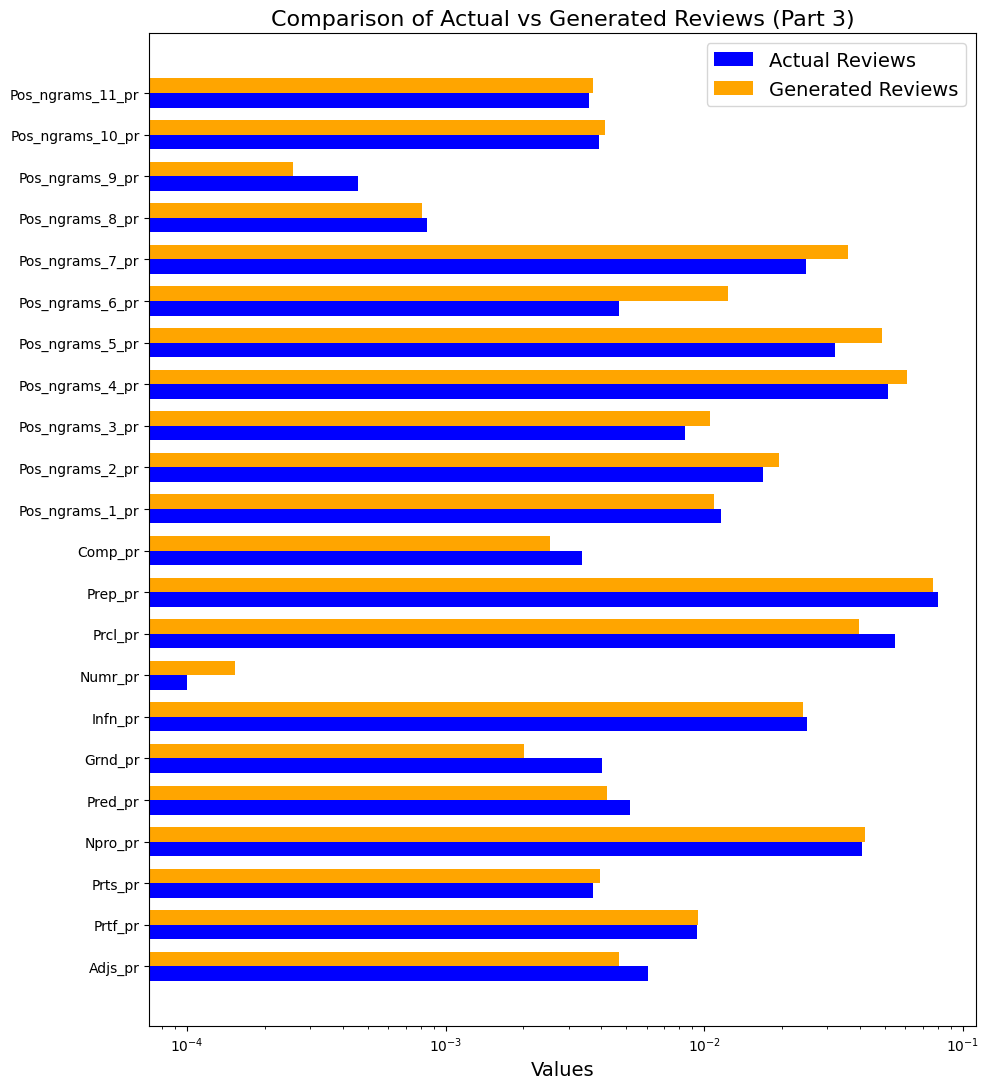
Regarding the distribution of case proportions (metrics Ablt_pr and Gen_pr), human-written texts have slightly fewer noun forms in the Ablative and Genitive than generated texts, but more in the Locative (loct, Figure 6). If we examine the distributions of words of different ranks according to Zipf’s law we surprisingly find that generated reviews contain more words of rank 1 and 2 (the less frequent ones) than written reviews. Taking into account the genre type of texts from our collection, we explain this observation by the fact that LLMs are more attentive to the details of film plots or personage names, professions etc., than humans are. For the other ranks, there are practically no differences.
Figure 6. Comparison of values of text complexity metrics in written reviews (actual) and generated reviews. Part 4
Рисунок 6. Сравнение значений метрик сложности текста в двух выборках: написанных и сгенерированных отзывах. Часть 4

Figure 7. Comparison of values of text complexity metrics in written reviews (actual) and generated reviews. Part 5
Рисунок 7. Сравнение значений метрик сложности текста в двух выборках: написанных и сгенерированных отзывах. Часть 5
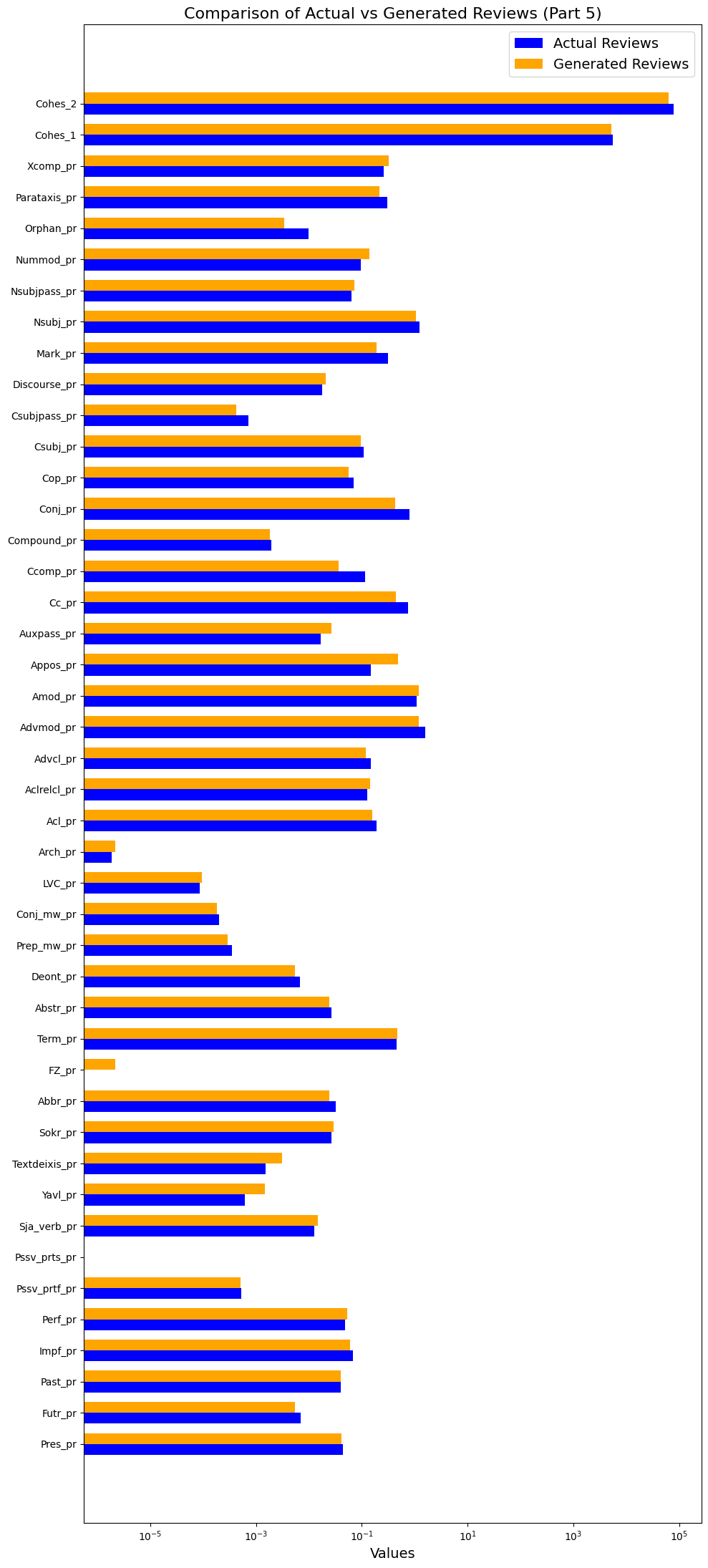
As for syntactical metrics (Figure 7), they testify that in written texts syntactical structures seem to be slightly more “fancy” than in reviews generated by LLM. For example, such metrics as the Proportion of elliptical predicate constructions (Orphan_pr), Proportion of constructions with clausal complements (Ccomp_pr, ex.g: Мне кажется (clausal complements), фильм был снят наспех; Он убедил меня в том, что фильм хорош (clausal complements)), Proportion of conjunctions associated with conjuncts by the syntactic relation "cc" (coordination) (Cc_pr, ex.g: …какдетям, такивзрослым), share of passive constructions "with a sentential subject" (Csubj:pass_pr, ex.g.: Поднималасьпроблемаонеобходимостижертвоватьрадидругих) have higher values in written texts than in generated. For instance, compare fragments of two reviews from our parallel dataset (Table 4): in the written text we find four cases of elliptical predicate constructions, in the generated – only one; in the written – three cases of clausal complements, in generated – only one.
Table 4. Two texts from the parallel dataset to demonstrate difference in elliptical predicate constructions (EPC) and clausal complements (CC)
Таблица 4. Два текста из параллельного датасета: отличия в использовании эллиптических предикативных конструкций и сентенциональных дополнений
However, generated texts of review contain more appositional modifiers (Proportion of appositional modifiers − Appos_pr, ex.g.: Элизабет, любовница главного героя, принимает решение...), deictic words (Textdeixis_pr, ex.g.: этот фильм вышел в 2017 году) and forms of the verb являться (equivalent of to be in English; Yavl_pr) than texts produced by humans.
Summarizing the results, we can say that, although in general the differences in the values of the metrics cannot be called significant, several trends can be seen.
Firstly, written texts, unlike generated texts, have a slightly more complex syntactic structure (more commas, ellipses, clausal complements, etc.). These syntactic features are induced by the desire of the speaker, a social subject, to express their personal judgment, opinion.
Second, it appears that human authors are more likely to vary lexical units and constructions than generative models. The latter, on the other hand, show a predilection for part of speech bi- and trigrams including a noun or even a chain of nouns. They also avoid non-nucleus forms of expressing predicativity and are predisposed to use the vocabulary of low and medium frequency.
Thirdly, the generated texts, if compared to written reviews, contain a greater number of numerical symbols and deictics, which is probably due to the greater attention to details seeable in the synthetical reviews.
5.3. Human evaluation test
In our human evaluation test, we obtained a total of 4534 evaluations of 36 mixed (synthetical and human-written) texts from 130 informants. As some informants did not evaluate the entire sample, the number of estimates collected is less than expected.
Only 25% of synthetical texts from our mixed sample were identified correctly; in 75% of responses for this group, generated texts were taken for human-written.
As for the human-written texts, in 39% of responses the written texts from our mixed sample were wrongly labeled as synthetical; in 61% of cases label was attributed correctly (Table 5).
Table 5. Results of assessment
Таблица 5. Результаты оценки
It suggests that participants found it more difficult to differentiate artificial reviews generated by LLM from human-written reviews and less difficult to differentiate human-written reviews from generated ones.
After having rated all texts, the informants were asked to formulate some principals they were guided by while deciding about the naturalness and human-written or AI generated character of texts they were exposed to. In Table 6 we summarize our informants’ intuitions.
Table 6. Synthetical texts and human-written texts features as they are assumed by informants according to their comments (“+” marks the features that are thought being proper to the text category, “-”– not proper)
Таблица 6. Признаки сгенерированных и написанных (естественных) текстов по интроспективным ощущениям информантов, отраженным в комментариях (“+” – признак присутствует, “-” – признак присутствует)
Thus, in this table (Table 6), we have tried to summarize how informants conceive “naturalness” (i.e., characteristics of exclusively “human” use of natural language for the task of writing a review) and “artificiality” (i.e., characteristics inherent in the way artificial intelligence uses natural language for the same task).
Naturalness is conceptualized by informants as a set of text characteristics that are a projection of informants’ stereotyped representation of human thinking abilities, such as (numerals in brackets are assigned according to the linguistic features listed in Table 6):
- the human ability to formulate complex and multi-component judgements (4);
- the possible aberrations in human thought processes (5);
- emotionality of thinking and the tendency to lose rational control in favor of emotionality (20, 24);
- mind flexibility permitting to the Humans to merge entity by sophisticatedly combining heterogeneous elements (9, 13, 17);
- mind rootedness in personal life and social routines (15, 22).
As for unnaturalness representation (syntheticalness), the informants conceptualized it as a projection of their stereotypes about AI thinking abilities, such as:
- stereotypical flow of thoughts (2; 6);
- limited set of cognitive structures and their repetitiveness (14, 16);
- categorization based on only explicit entities features, incapability to deal with implicit links (3);
- erratic patterns of thinking and memorizing things (12, 18);
- exactitude of memorizing items even erratic (19);
- no link with life experience or social routines (21, 23).
We supposed that this kind of viewing could be partially conditioned by autostereotypes of humans about themselves and their heterostereotypes about “machines” and as such could be misleading in defining what text is more natural.
To verify this, we did an expert analysis of a sample of mislabeled texts: written texts wrongly assessed by our group of informants as being synthetical or synthetical texts wrongly assessed as written. Our main assumption was:
- we know the true label of the texts;
- informants wrongly placed them in the category which is not appropriate;
- if we find in written texts a considerable number of features of synthetical texts / in generated texts a number of features of written texts as they are perceived by informants, then human evaluators are misled by their intuitions and then – they actually trust them.
Below, we consider two examples of written texts wrongly judged by assessors to be synthetic.
Text 1 (false positive: written assessed as generated)
57 % of informants categorized it as synthetic, 43% – human-written
Этот фильм ужасен, ужасен в том смысле, что он показывает человека с такой стороны, с которой никто бы не хотел его видеть. Это фильм о простых людях, которые получили власть, пусть маленькую, над одним человеком, но все же власть. В этом шедевре мирового кинематографа показывается, как все-таки могут люди ненавидеть друг друга и в кого они могут превращаться: в псов, в животных или еще ниже. Надо сказать, что это очень тяжелый фильм, но смотрится на одном дыхании от начала до конца, и ты не замечаешь, как проходит три часа. Бесспорно 10 из 10 (This movie is horrible, horrible in the sense that it shows a side of man that no one would want to see. It is a movie about ordinary people who have been given power, albeit small, over one person, but power nonetheless. This masterpiece of world cinematography shows how people can hate each other and who they can turn into: dogs, animals or even lower. I must say that it is a very heavy movie, but it is watched in one breath from the beginning to the end, and you don’t notice how three hours pass. Undoubtedly 10 out of 10).
Table 7. Features of naturalness and artificialness from informants’ comments (each number refers to the text feature given in Table 6) detected by experts in the Text 1
Таблица 7. Обнаруженные экспертами в Тексте 1 признаки естественности и искусственности, сформулированные информантами в комментариях (номера соответствуют порядковому номеру признака в таблице 6)
In Text 1, the experts detected the following features of a synthetic text: clichéd expressions and collocations, enumerations, repetitive structure of proposition “general assumption, precision” (power, but only over one person; heavy film, but it is watched in one breath). Among the written text features the experts found: playing with different senses of a polysemantic words (horrible in the sense of...), complex syntax (the first sentence), evaluation and opinion prevail over facts and details (evaluative epithets: very heavy movie).
Text 2 (false positive: written assessed as generated)
68 % of responses − synthetic, 32% – human-written
Фильм, является гениальным. Из-за его простоты, точней отсутствия в картине массы декораций (стены домов, трава и т.п.) он заставляет сосредоточиться исключительно на людях. Весь фильм ты проживаешь не реальным миром, его красотой, а его героями, людьми, их эмоциями и чувствами, переживаниями и размышлениями. Ты с головой окунаешься в мир человека нуждающегося в помощи. Ощущаешь доброту, проявленную с опаской, а после и вовсе ушедшей из жизни данных людей. Волки… Они вгрызаются все глубже, вырывая с каждым разом все больший кусок мяса… Страх – именно он делает нас животными, но разве есть у нас сила сопротивляться ему? Ты смотришь в свою душу и пытаешься увидеть себя другим, понять, что у тебя нет ничего общего с Ними – и осознаешь, что ты тоже один из Них, ты зверь. Меняться никогда не поздно…. Просмотр этой картины позволяет понять, что Людей в этом мире почти нет, и они не появятся из неоткуда… Надо стать ими. Нельзя продавать Добро, лишь утешая свой страх. Человек создан для того, чтобы бороться. И в первую очередь с самим собой… 10 из 10 [The movie is brilliant. Because of its simplicity, or rather the absence of a lot of scenery (walls of houses, grass, etc.), it makes you focus solely on people. The whole movie you live not in the real world, its beauty, but in its characters, people, their emotions and feelings, experiences and reflections. You plunge headlong into the world of a person in need of help. You feel the kindness, shown with fear, and afterwards and completely gone from the life of these people. Wolves... They bite deeper and deeper, tearing out a bigger piece of meat each time... Fear is what makes us animals, but do we have the power to resist it? You look into your soul and try to see yourself differently, to understand that you have nothing in common with Them – and realize that you are also one of Them, you are a beast. It’s never too late to change.... Viewing this film makes you realize that there are almost no People in this world, and they will not appear out of nowhere... You have to become them. You can’t sell the Good just to comfort your fear. Man was created to fight. And first of all with himself... 10 out of 10]
Table 8. Features of naturalness and artificialness from informants’ comments (each number refers to the text feature given in the Table 6) detected by experts in the Text 2
Таблица 8. Обнаруженные экспертами в Тексте 2 признаки естественности и искусственности, сформулированные информантами в комментариях (номера соответствуют порядковому номеру признака в таблице 6)
The analysis demonstrates that a number of characteristics of the text under discussion (written text) do indeed bring it closer to the generated text as it is perceived by informants: violation of lexical combinatorics (Весь фильм ты проживаешь не реальным миром, его красотой… – проживать+Ablativus), enumeration (его героями, людьми, их эмоциями…), broken logical connection (a passage that first talks about people and their experiences and then suddenly conjures up the image of wolves), and parcellations (Людей в этом мире почти нет, и они не появятся из ниоткуда… Надо стать ими).
At the same time, the text fragment contains some human specific features: a sort of semantic play based on the polysemy of the noun простота (1. simplicity; 2. Naiveness: Из за его простоты, точней отсутствия в картине массы декораций); rhetoric question, metaphors which testify the predominance of attitudes and emotions over facts and details (Страх – именно он делает нас животными, но разве есть у нас сила сопротивляться ему?); specific “strange” style inherent to the entire text.
As we can see, when assessing the naturalness of texts, our informants overestimate the human ability to formulate complex judgments and the flexibility of the mind, and at the same time – the stereotypical way of thinking typical of AI. As we see, actually, humans could produce texts by altering both strategies: repetitive patterns and those which are based on their surprising “fuzzy” logic, motivated by lived life experience and imagination.
When we applied the same analytic procedure of feature annotation to the subsample of synthetic texts labeled as written, we obtained the following distribution of features in them (Figure 8). The bar charts show that the informants, while assessing texts, were actually misled by features connected to such categories as text affectivity, stylistic devices (e.g. “comparison” Режиссер словно пытается переписать на модный музыкальный центр старую затасканную кассету [It’s like the director is trying to re-record an old hackneyed cassette tape on a fancy music centre]) and textual categories (e.g. “reference to personal experience” Посмотрел этот фильм по совету друзей [Watched this film on the advice of friends]). Being charmed by Human likness of emotions, style and text “actualness” the informants didn’t focus on wrong lexical combinations (e.g. Но нет намёка о том…) nor syntactical trivialness (e.g. Великолепная актерская игра, тонкий юмор, потрясающий саундтрек делают этот фильм непревзойденным [Great acting, subtle humour, and a terrific soundtrack make this film second to none]).
Figure 8. Distribution of features in the sample of synthetical texts wrongly attributed by informants to human-written
Рисунок 8. Распределение признаков в корпусе сгенерированных текстов, ошибочно атрибутированных информантами к категории написанных человеком
In other words, those informants who focused their attention on textual, stylistic and affective categories of text characteristics, overestimating their importance due to the influence of the mentioned above autostereotypes, made the wrong decision about text attribution.
6. Discussion
Naturalness in the “pre-AI” era was viewed from the dichotomy of “an experienced language user within a given community vs a person who has not fully mastered language community’s routines”. In the AI era, the scale of naturalness has acquired another vector: who is the author of the text - a human (in which case the text is natural) or a "machine" (in which case it is artificial or synthetic)?
Our study attempted to look at naturalness within this latter scale from three perspectives: a formal metric for assessing the differences between two adjacent sentences (self-BLEU), metrics of linguistic text complexity, and a psycholinguistic experiment.
The values of self-BLEU metric measured for human-written texts showed that naturalness at this side can be regarded as a relatively low level of difference between two adjacent sentences. As linguists, we understand that this is due to the realization of the category of cohesion (grammatical, lexical) as an integral category of every normal human-written text. However, this formal approach does not seem sufficient for defining naturalness.
From very linguistic point of view, naturalness could be seen as a text characteristic that is due to human ability to get access to first-order mental structure (Thibault, 2011) (e.g. “mental spaces” in Fauconnier’s sense (Fauconnier, 1981), or “scene” – in Talmy’s theory (Talmy, 2000)) using second-order structures − words and grammatical patterns. While processing words, language users keep the whole imagined scene in their cognitive view. This enables specific linguistic properties of “natural” text:
- Predicativity that dominates nominativity;
- Sentence syntactical incompleteness that does not interfere with understanding;
- Sentences with sentential subject and complement;
- Comparative constructions;
- Mid- and high frequency vocabulary, but diverse.
Since the speaker always has access to the whole first-order mental structure (scene representation), they can easily divide it into different segments and then – by means of language (second-order structures) – establish complex and multilevel relations between them (such as causality; anteriority – simultaneity – posteriority; comparison; second-order structures, etc.). The language users feel free to skip some parts of second-order structures (e. g. ellipses), shorten them, because they are easily reconstructed by the hearer/ reader, who, while understanding, tries to build up an analogously accessible representation (first-order structure) of the described scene. These iteractions between second-order and first-order structures make it possible to name entities of mental structures by using diverse words according to the movement of the window of cognitive attention. This capacity to have simultaneous access to the structures belonging to different cognitive orders while writing or speaking differs Humans from AI because the latter generates texts by operating on the same order of structures (tokens, lemmas) using the principle of “guess-the-next-word”. According to Bender et al., 2021, “LM is a system for haphazardly stitching together sequences of linguistic forms it has observed in its vast training data, according to probabilistic information about how they combine, but without any reference to meaning: a stochastic parrot” (Ibid: 617).
In other words, when prompting or training a model we should encourage the LLM to pay attention to the mentioned above features to gain in naturalness.
However, in psycholinguistic perspective, the naturalness appears as a set of expectations that people have from themselves as Humans. When assessing texts and deciding who is the author (Human or AI), people anticipate these expectations overestimating text features that correspond to them. Psycholinguistically, naturalness is conceptualized as a collection of text features that reveal human ability:
- to formulate complex judgments;
- to merge very different entities on the basis of fuzzy logic principles;
- to be emotion dominated;
- to be socially sensitive, sometimes affected by logic aberration;
- to be able to give reference to his personal life.
If we want to generate text with a maximum of human likeness, we should also take these pertinent expectations into account when collecting training data or thinking about prompting strategies (Wei et al., 2023).
Obviously, there is some correlation between the concept of naturalness as it is seen in those two perspectives: linguistic and psycholinguistic. For example, the informants’ expectation that Humans produce more complex thoughts than AI finds its counterpart in such linguistic features of human texts as high values of the metrics of Proportion of elliptical predicate constructions, Proportion of clausal complements, Proportion of units capable of attaching dependent clauses etc. Nevertheless, there are many expectations manifested by the informants in experimental study, but still hardly detectable by text complexity metrics (e.g. social sensitiveness or fuzzy logic principles in combining thoughts and words).
7. Conclusion
The conducted research has shown that in the situation of the permanently growing power of LLMs, the category of text naturalness needs to be revised. Nowadays, when thinking about naturalness, we mean such text properties which are “inalienable” from Humans, properties which are derived from human nature in itself and cannot be imitated by AI.
To define text naturalness in such context, we created a parallel corpora of human-written film reviews and reviews generated by using prompts from the written reviews; to compare corpora, we applied a formal metric of text diversity, a set of metrics of text complexity and we organized a psycholinguistic experiment by inviting informants to assess text naturalness, to label each text “written” or “generated”, and to articulate their introspective intuitions about text naturalness features.
Our comparative analysis of text complexity metrics in written and generated texts didn’t demonstrate any absolutely significant differences in metrics values. However, by summarizing the majority of discrepancies existing between values obtained in two compared subcorpora, we gave a definition of naturalness as a text category: it is a set of text features allowed by human ability to simultaneously operate by first-order structures (mental representations) and second-order structures (words and grammatical constructions). In practice, such naturalness manifests itself in more complex and nuanced syntactic relations between sentence parts, possibility to vary the level of syntactic structures completeness, rather high word diversity, use of sophisticated punctuation.
Taken as a psycholinguistic category, naturalness can be perceived as a set of intersubjective expectations based on autostereotypes that Humans privilege while thinking about themselves: some of them are true, other – illusory. In practice, such naturalness manifests itself in linguistic means to express emotions, to appeal to life experience, to avoid all kinds of repetitions, to generate new meanings by using stylistic devices and implicit links.
The obtained results also showed some new perspectives in detecting naturalness. The first interesting thing to do in further research is to compare how Zipf's law is fulfilled in natural and syntactic texts. The second consists in training LLM according to informants’ intuitions collected in our experiment and to do another assessment.
[1] Sber Devices (2021). Hugging Face: ruGPT3Large, available at https://huggingface.co/ai-forever/rugpt3large_based_on_gpt2 (Accessed 24 March 2024).
Благодарности
Статья подготовлена по материалам проекта «Текст как Big Data: методы и модели работы с большими текстовыми данными», выполняемого в рамках Программы фундаментальных исследований НИУ ВШЭ в 2024 году.



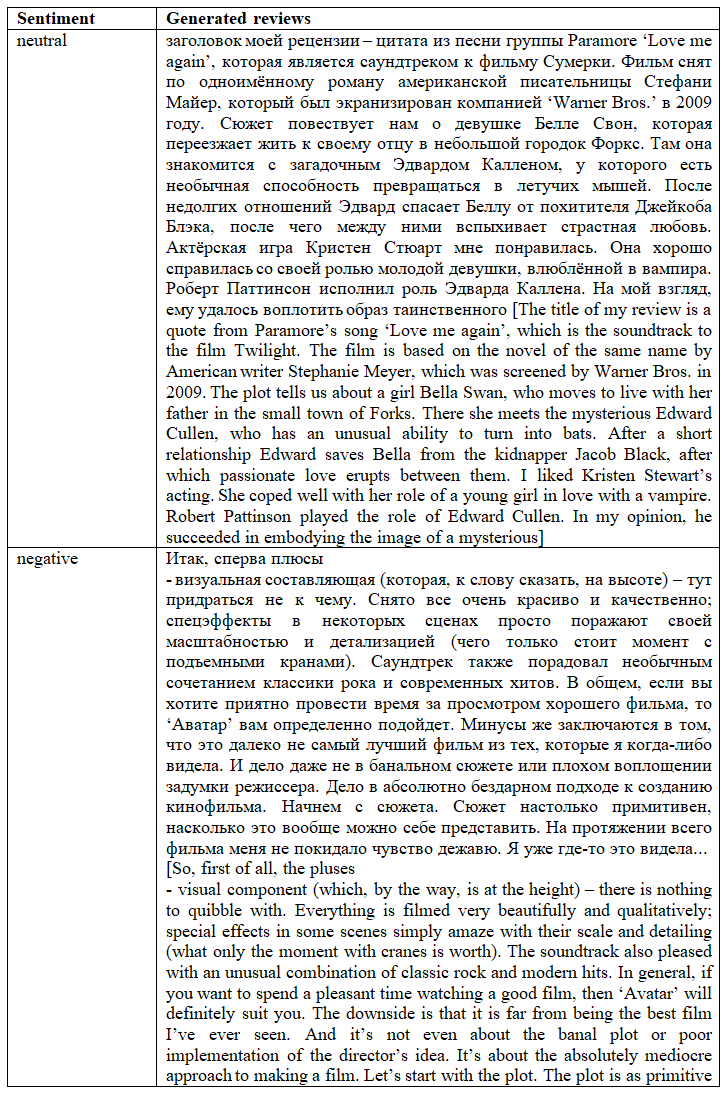
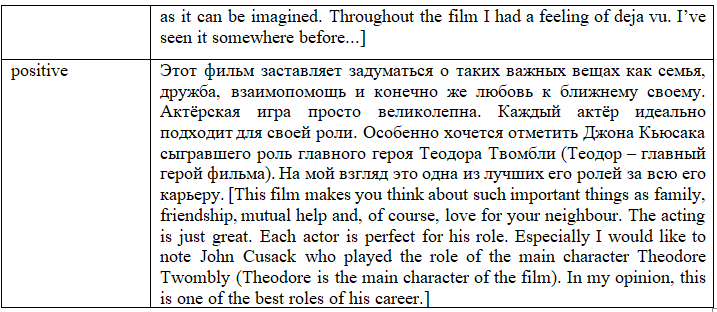
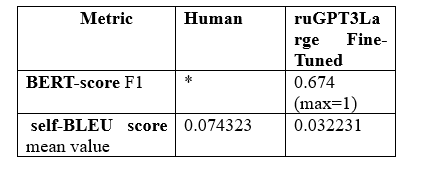
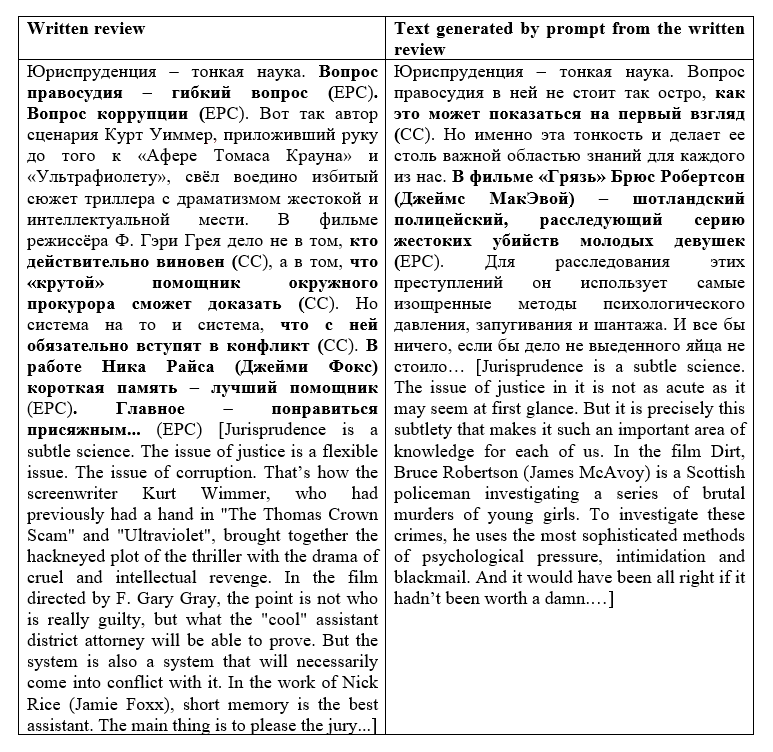

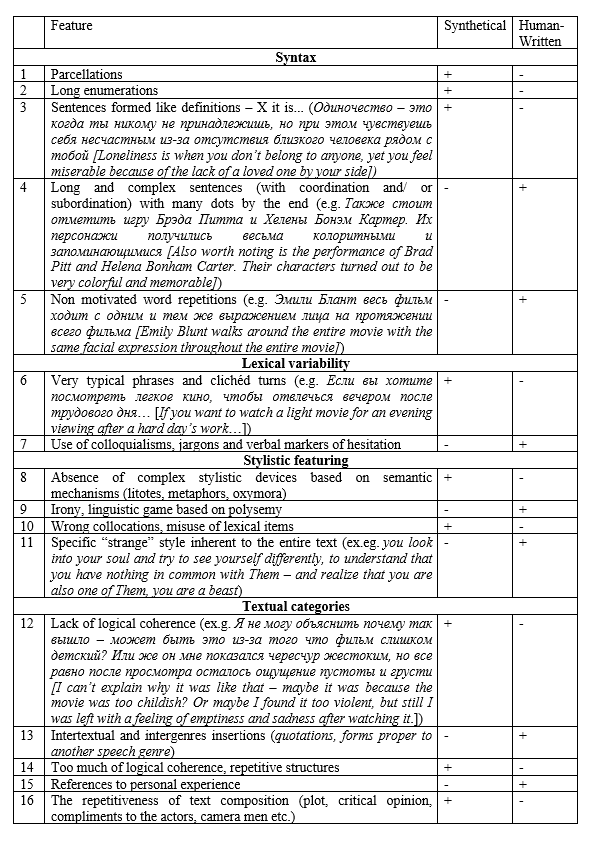

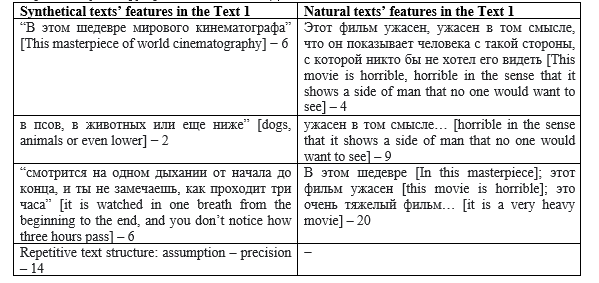
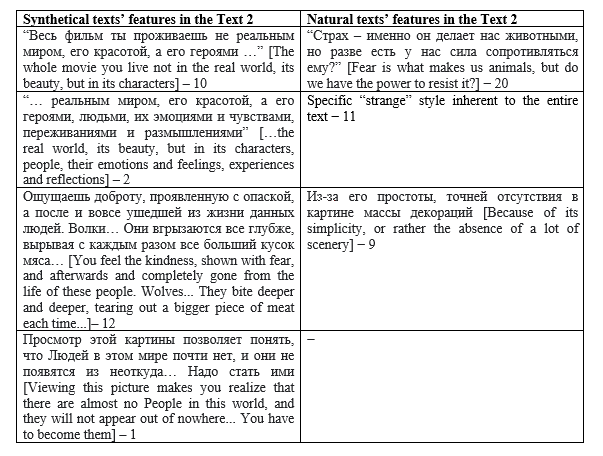
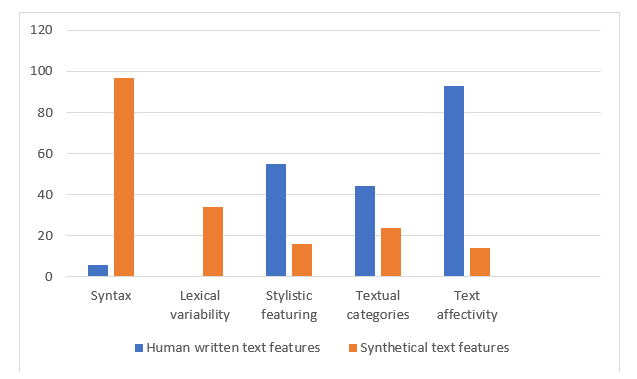
















Список литературы
Alzahrani, E. and Jololian, L. (2021). How Different Text-Preprocessing Techniques Using The BERT Model Affect The Gender Profiling of Authors, arXiv preprint arXiv: 2109.13890. https://doi.org/10.48550/arXiv.2109.13890 (In English)
Bally, Ch. (1913). Le language et la vie, Edition Atar, Paris, France. (In French)
Bender, E. M., Gebru, T., McMillan-Major, A. and Shmitchell, Sh. (2021). On the dangers of stochastic parrots: Can language models be too big?, Proceedings of the 2021 ACM Conference on Fairness, Accountability, and Transparency, 610–623. (In English)
Blinova, O. and Tarasov, N. (2022). A hybrid model of complexity estimation: Evidence from Russian legal texts, Frontiers in Artificial Intelligence, 5. https://doi.org/10.3389/frai.2022.1008530 (In English)
Celikyilmaz, A., Clark, E. and Gao, J. (2021). Evaluation of text generation: A survey, arXiv preprint arXiv: 2006.14799. https://doi.org/10.48550/arXiv.2006.14799 (In English)
Dashela, T. and Mustika, Y. (2021). An Analysis of Cohesion and Coherence in Written Text of Line Today about Wedding Kahiyang Ayu and Bobby Nasution, SALEE: Study of Applied Linguistics and English Education, 2 (2), 192−203. https://doi.org/10.35961/salee.v2i02.282 (In English)
Fauconnier, G. (1981). Pragmatic functions and mental spaces, Cognition, 10 (1-3), 85−88. (In English)
Holtzman, A., Buys, J., Du, L., Forbes, M. and Choi, Y. (2019). The Curious Case of Neural Text Degeneration, arXiv preprint arXiv: 1904.09751. https://doi.org/10.48550/arXiv.1904.09751 (In English)
Lavie, A. &Agarwal, A. (2007). METEOR: An automatic metric for MT evaluation with high levels of correlation with human judgments, Proceedings of the Second Workshop on Statistical Machine Translation, 228–231. (In English).
Li, C., Zhang, M. and He, Y. (2022). The Stability-Efficiency Dilemma: Investigating Sequence Length Warmup for Training GPT Models, arXiv preprint arXiv: 2108.06084v4. https://doi.org/10.48550/arXiv.2108.06084 (In English)
Lin, Ch-Y. (2004). Rouge: A package for automatic evaluation of summaries, Text summarization branches out, 74–81. (In English)
Liu, X., Ji, K., Fu, Y., Lam Tam, W., Du, Zh., Yang, Zh. and Tang, J. (2022). P-Tuning v2: Prompt Tuning Can Be Comparable to Fine-Tuning Universally Across Scales and Tasks, arXiv preprint arXiv: 2110.07602.https://doi.org/10.48550/arXiv.2110.07602 (In English)
Margolina, A.V. (2022). Controlling impression: making ruGPT3 generate sentiment-driven movie reviews, Journal of Applied Linguistics and Lexicography, Vol. 4., 1, 15-25. (In English)
Margolina, A., Kolmogorova, A. (2023). Exploring evaluation techniques in controlled text generation: a comparative study of semantics and sentiment in ruGPTLarge-generated and human-written movie reviews, Computational Linguistics and Intellectual Technologies: Papers from the Annual International Conference, 1082-1090. (In English).
Mikhaylovskiy, N. (2023). Long story generation challenge, Proceedings of the 16th International Natural Language Generation Conference: Generation Challenges, 10–16. (In English)
Mnih, V., Kavukcuoglu, K., Silver, D. et al. (2015). Human-level control through deep reinforcement learning, Nature, 518 (7540), 529–533. http://dx.doi.org/10.1038/nature14236 (In English)
Newmark, P. (1987). Manual de traducción. Madrid: Ediciones Cátedra. (In Spanish)
Novikova, J., Lemon, O. and Reiser, V. (2016). Crowd-sourcing NLG data: Pictures elicit better data, Proceedings of 9th International Natural Language Generation Conference, 265–273. DOI: 10.18653/v1/W16-6644 (In English)
Obeidat, A. M., Ayyad, G. R., Sepora, T. and Mahadi, T. (2020). The tension between naturalness and accuracy in translating lexical collocations in literary text, Journal of Social Sciences and Humanities, 17 (8), 123–134. (In English)
Orešnik, J. (2002). Naturalness in English: some (morpho)syntactic examples, Linguistica, 42. DOI: 10.4312/linguistica.42.1.143-160 (In English)
Rachmawati, S., Sukyadi, D. and Samsudin, D. (2021). Lexical cohesion in the commercial advertisements of five Korean magazines, Journal of Korean Applied Linguistics, 1 (1), 29−44. (In English)
Rogers, M. (1998). Naturalness and Translation, SYNAPS: Journal of Professional Communication, 2 (99), 9–3. (In English)
Schramm, A. (1998). Tense and Aspect in Discourse, Studies in Second Language Acquisition, 20 (3), 433–434. https://doi.org/10.1017/s0272263198283069 (In English)
Schuff, H. & Vanderlyn, L. & Adel, H. & Vu, Th. (2023). How to do human evaluation: A brief introduction to user studies in NLP, Natural Language Engineering, 29, 1-24. DOI: 10.1017/S1351324922000535 (In English)
Serce, G. (2014). Relationship between naturalness and translations methods: Towards an objective characterization, Synergies Chili, 10, 139−153. (In English)
Siipi, H. (2008). Dimensions of Naturalness, Ethics and the Environment, 13 (1), 71−103. https://doi.org/10.2979/ETE.2008.13.1.71 (In English)
Sinclair, J. (1983). Naturalness in language, in Aarts, J. and Meys, W. (eds.), Corpus Linguistiсs, 203−210. (In English)
Talmy, L. (2000). Toward a cognitive semantics, vol. 2: Typology and process in concept structuring. Cambridge, Mass.: MIT Press (In English)
Thibault, P. J. (2011). First order languaging dynamics and second order language: The distributed language view, Educational Psychology, Vol.V, 32, 210–245. (In English)
Venuti, L. (1995). The translator’s invisibility, Routledge, London and New York. (In English)
Wei, J., Wang, X., Schuurmans, D., Bosma, M., Ichter,D., Xia,F., Chi E., Le Qu., Zhou D. (2023). Chain-of-Thought Prompting Elicits Reasoning in Large Language Models, arXiv:2201.11903. https://doi.org/10.48550/arXiv.2201.11903 (In English)
Wilson, D. (1998). Discourse, coherence and relevance: A reply to Rachel Giora, Journal of Pragmatics, 29 (1), 57−74. (In English)
Zhang, T., Kishore, V., Wu, F., Weinberger, K. Q. and Artzi, Y. (2020). BERTscore: Evaluating text generation with BERT, arXiv preprint arXiv: 1904.09675. https://doi.org/10.48550/arXiv.1904.09675 (In English)
Zhou, J. and Bha, S. (2021). Paraphrase generation: A survey of the state of the art, Proceedings of the 2021 Conference on Empirical Methods in Natural Language Processing, 5075–5086. (In English)
Zhu, Y., Lu, S., Zheng, L., Guo, J., Zhang, W., Wang, J. and Yu, Y. (2018). Texygen: A Benchmarking Platform for Text Generation Models, arXiv preprint arXiv: 1802.01886.https://doi.org/10.48550/arXiv.1802.01886 (InEnglish)